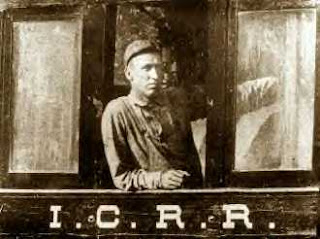Casey Jones, known as the Brave Engineer, is an American
folk hero. April 30, 1900, he died when his passenger train collided with a
stalled freight train at the Vaughan, Mississippi station on a foggy and rainy
night. His dramatic death while trying to stop his train and save the lives of
his passengers made him a hero. He was immortalized in a popular ballad song by
his friend, Wallace Saunders.
Born Jonathan Luther Jones on March 14, 1863, Jones grew up
near Cayce, Kentucky where he acquired the nickname, “Cayce” which he would
later spell as “Casey.” He married Mary Joanna “Janie” Brady on November 25,
1886. They would have three children: Charles (1888-1977), Helen (1890-1979)
and John Lloyd (1896-1934). By all accounts, Jones was a devoted family man.
Jones was promoted to engineer on February 23, 1891. As railroading was a
talent, Jones was recognized by his peers to be one of the best engineers in
the business. He was known for his insistence to get the train in on time and
never fall behind schedule. He was so punctual that people set their watches by
him. He was also famous for his particular train whistle. Made of six thin
tubes bound together, its unique sound involved a long-drawn out note which
began softly, rose and then faded to a whisper. People living along the rail
line would hear it and claim “There goes Casey Jones.” A bit of a risk taker,
Jones was ambitious and eager to move up the ranks and serve on the better
paying and more prestigious passenger trains.
In February 1900, Jones transferred to Memphis, Tennessee
for the passenger run between Memphis and Canton, Mississippi. On April 30,
Jones and his crew departed Memphis at 12:50 am, 75 minutes behind schedule.
The weather was foggy and rainy with reduced visibility and tricky curves on
this particular run. The run started well and Jones was able to gain momentum
get back on schedule. Unknown to Casey, three separate trains were at the
Vaughan station. The No. 83 train was stalled on the switch track, leaving the
rear cars on the main line and in Jones’ path. As Jones approached, a left-hand
curve blocked his view, it wasn’t until his fireman, Sim Webb cried, “Oh my
Lord. There’s something on the main line.” Jones told Webb to jump and reversed
the throttle and slammed on the airbrakes. He had reduced his speed from 75 mph
to 35 mph when he hit. Because Jones stayed on board, it is believed he saved
the passengers from serious injury and death. His watch stopped at time of
impact at 3:52 am. Popular legend holds that when his body was found, he was
still clutching the whistle cord and brake. The final accident report placed
the responsibility on Jones who was said to have ignored the warning signals
given by No. 83. His fireman, Webb, claimed and swore until his death in 1957,
that they did not see or hear any warnings. Historians today dispute the
official report. They find it difficult, if not impossible, to believe that an
engineer of Jones’ experience would have ignored the different warnings that
would have alerted him to the danger.
Casey Jones’ fame could be attributed to the traditional
song, The Ballad of Casey Jones. Soon
after his death, the song was first sung by engine wiper and friend of Jones,
Wallace Saunders. He was known to sing and whistle the song to the tune of
“Jimmie Jones.” Unfortunately, Saunders never copyrighted his lyrics, so it is
difficult to known what his lyrics were. But the song would travel the country
as railroaders picked up the song and vaudeville performers, T. Lawrence
Seibert and Eddie Newton copyrighted their music and lyrics for the song. By
WWI, dozens of versions of the song had been published and millions of copies
were sold. The poet, Carl Sandburg, called Casey
Jones – The Brave Engineer, the greatest ballad ever written. The song has
been recorded numerous times and Casey Jones’ name has become a household name.
Casey Jones has become a mythological figure like Pecos Bill
or Paul Bunyan. He was a real life hero whose legend grew as people talked
about him. He stayed on the train in order to slow it down and the save the
lives of the passengers who was entrusted to his care. On this day, the 116th
anniversary of his heroic act, I remember Casey Jones: the man, the legend.




No comments:
Post a Comment